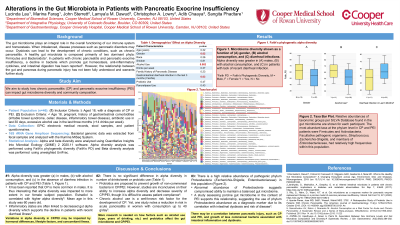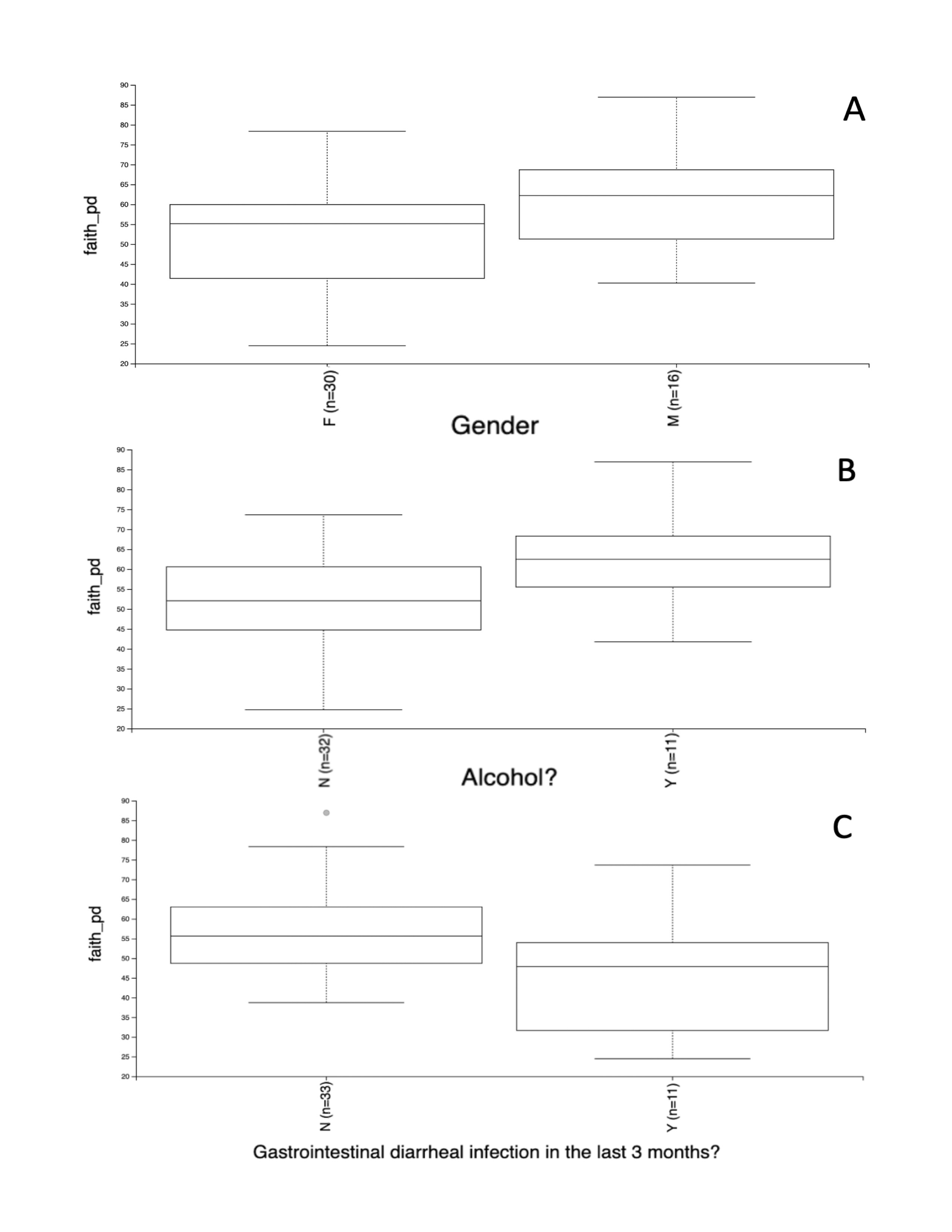Monday Poster Session
Category: Biliary/Pancreas
P1776 - Alterations in the Gut Microbiota in Patients With Pancreatic Exocrine Insufficiency
Monday, October 28, 2024
10:30 AM - 4:00 PM ET
Location: Exhibit Hall E

Has Audio

Lucinda Lau, BS
Cooper Medical School of Rowan University
Camden, NJ
Presenting Author(s)
Lucinda Lau, BS1, Marina Farag, BA1, John Sterrett, MS2, Lamya'a Dawud, PhD2, Christopher A. Lowry, PhD2, Adib Chaaya, MD3, Sangita Phadtare, PhD1
1Cooper Medical School of Rowan University, Camden, NJ; 2University of Colorado Boulder, Boulder, CO; 3Cooper Health Gastroenterology, Camden, NJ
Introduction: The gut microbiome plays an integral role in the overall functioning of our immune system and homeostasis. When imbalanced, disease processes such as pancreatic disorders may occur. Still, there exists a somewhat unclear relationship between the gut and pancreas during pancreatic injury. Our aim is to study how chronic pancreatitis (CP) and pancreatic exocrine insufficiency (PEI) can impact gut microbiome diversity and community composition to establish a more thorough evaluation of the gut microbiome in this population.
Methods: Stool samples from 46 CP or PEI patients were collected. Bacterial DNA was extracted from fecal samples using a Qiagen DNeasy PowerSoil HTP extraction kit. Golay barcode primers 515 F and 806 R were used for 16S rRNA gene sequencing. Alpha and beta diversity were analyzed using Quantitative Insights Into Microbial Ecology (QIIME) 2 2020.11. Comparison of within-sample diversity (alpha diversity) was performed using Faith’s phylogenetic diversity (Faith’s PD) and comparison of between-sample diversity, i.e. community composition (beta diversity), was performed using unweighted UniFrac.
Results: The most abundant taxa in CP and PEI patients were Bacteroides, Firmicutes, and Actinobacteria. Facultative pathogenic organisms Streptococcus, Escherichia-Shigella, and other Enterobacteriaceae had relatively high frequencies within this population. Alpha diversity was significantly lower in females (p=0.0301), in participants with no alcohol consumption (p=0.0104), and participants with GI diarrheal infections in the last 3 months (p=0.0333) (Figure 1). No association was found between alpha diversity and use of probiotics or pancrelipase medications (Table 1).
Discussion: The high relative abundances of pathogenic bacteria, particularly phylum Proteobacteria, suggest a correlation between pancreatic injury and growth of less commensal bacteria. A study assessing a porcine model gut microbiome in the context of PEI supports this relationship, suggesting the use of phylum Proteobacteria abundance as a diagnostic marker due to its correlation with intestinal dysbiosis and risk of disease. This study also identifies factors such as gender and alcohol use that may warrant further exploration in future studies to determine their impact on gut biodiversity in CP and PEI patients. These observations may help reform future clinical care strategies for managing these conditions through targeting of pathogenic gut microorganisms.

Note: The table for this abstract can be viewed in the ePoster Gallery section of the ACG 2024 ePoster Site or in The American Journal of Gastroenterology's abstract supplement issue, both of which will be available starting October 27, 2024.
Disclosures:
Lucinda Lau, BS1, Marina Farag, BA1, John Sterrett, MS2, Lamya'a Dawud, PhD2, Christopher A. Lowry, PhD2, Adib Chaaya, MD3, Sangita Phadtare, PhD1. P1776 - Alterations in the Gut Microbiota in Patients With Pancreatic Exocrine Insufficiency, ACG 2024 Annual Scientific Meeting Abstracts. Philadelphia, PA: American College of Gastroenterology.
1Cooper Medical School of Rowan University, Camden, NJ; 2University of Colorado Boulder, Boulder, CO; 3Cooper Health Gastroenterology, Camden, NJ
Introduction: The gut microbiome plays an integral role in the overall functioning of our immune system and homeostasis. When imbalanced, disease processes such as pancreatic disorders may occur. Still, there exists a somewhat unclear relationship between the gut and pancreas during pancreatic injury. Our aim is to study how chronic pancreatitis (CP) and pancreatic exocrine insufficiency (PEI) can impact gut microbiome diversity and community composition to establish a more thorough evaluation of the gut microbiome in this population.
Methods: Stool samples from 46 CP or PEI patients were collected. Bacterial DNA was extracted from fecal samples using a Qiagen DNeasy PowerSoil HTP extraction kit. Golay barcode primers 515 F and 806 R were used for 16S rRNA gene sequencing. Alpha and beta diversity were analyzed using Quantitative Insights Into Microbial Ecology (QIIME) 2 2020.11. Comparison of within-sample diversity (alpha diversity) was performed using Faith’s phylogenetic diversity (Faith’s PD) and comparison of between-sample diversity, i.e. community composition (beta diversity), was performed using unweighted UniFrac.
Results: The most abundant taxa in CP and PEI patients were Bacteroides, Firmicutes, and Actinobacteria. Facultative pathogenic organisms Streptococcus, Escherichia-Shigella, and other Enterobacteriaceae had relatively high frequencies within this population. Alpha diversity was significantly lower in females (p=0.0301), in participants with no alcohol consumption (p=0.0104), and participants with GI diarrheal infections in the last 3 months (p=0.0333) (Figure 1). No association was found between alpha diversity and use of probiotics or pancrelipase medications (Table 1).
Discussion: The high relative abundances of pathogenic bacteria, particularly phylum Proteobacteria, suggest a correlation between pancreatic injury and growth of less commensal bacteria. A study assessing a porcine model gut microbiome in the context of PEI supports this relationship, suggesting the use of phylum Proteobacteria abundance as a diagnostic marker due to its correlation with intestinal dysbiosis and risk of disease. This study also identifies factors such as gender and alcohol use that may warrant further exploration in future studies to determine their impact on gut biodiversity in CP and PEI patients. These observations may help reform future clinical care strategies for managing these conditions through targeting of pathogenic gut microorganisms.

Figure: Figure 1. Faith’s phylogenetic alpha diversity. Microbiome shown as a function of (A) gender, (B) alcohol consumption, and (C) gastrointestinal diarrheal infection.
Note: The table for this abstract can be viewed in the ePoster Gallery section of the ACG 2024 ePoster Site or in The American Journal of Gastroenterology's abstract supplement issue, both of which will be available starting October 27, 2024.
Disclosures:
Lucinda Lau indicated no relevant financial relationships.
Marina Farag indicated no relevant financial relationships.
John Sterrett indicated no relevant financial relationships.
Lamya'a Dawud indicated no relevant financial relationships.
Christopher Lowry indicated no relevant financial relationships.
Adib Chaaya indicated no relevant financial relationships.
Sangita Phadtare indicated no relevant financial relationships.
Lucinda Lau, BS1, Marina Farag, BA1, John Sterrett, MS2, Lamya'a Dawud, PhD2, Christopher A. Lowry, PhD2, Adib Chaaya, MD3, Sangita Phadtare, PhD1. P1776 - Alterations in the Gut Microbiota in Patients With Pancreatic Exocrine Insufficiency, ACG 2024 Annual Scientific Meeting Abstracts. Philadelphia, PA: American College of Gastroenterology.
